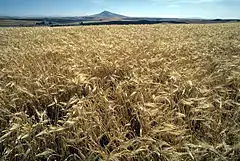Corn exchange
A corn exchange is a building where merchants trade grains. The word "corn" in British English denotes all cereal grains, such as wheat and barley; in the United States these buildings were called grain exchange. Such trade was common in towns and cities across England until the 19th century, but as the trade became centralised in the 20th century many such buildings were used for other purposes. Several have since become historical landmarks.
.jpg.webp)
In the United States, the Minneapolis Grain Exchange is still used to manage the commodities and futures exchange of grain products.[1]
History in England
Corn exchanges were initially held as open markets normally controlled by the town or city authorities. Dedicated corn exchanges start appearing in the earlier part of the 18th century, increasing greatly following the repeal of the Corn Laws in 1846.[2] They declined after the Great Depression of British Agriculture in the late 19th century.[3]
List of corn exchanges
Australia
Canada
Ireland
- Corn Exchange, Athy
- Corn Exchange, Dublin
- Corn Exchange, Wexford
United Kingdom
England
See also: Corn exchanges in England
- Corn Exchange, Alford
- Corn Exchange, Aylesbury
- Corn Exchange, Banbury
- Corn Exchange, Barton-upon-Humber
- Corn Exchange, Basingstoke
- Corn Exchange, Beccles
- Corn Exchange, Bedford
- Corn Exchange, Berwick-upon-Tweed
- Corn Exchange, Beverley
- Corn Exchange, Bishop's Stortford
- Corn Exchange, Blandford Forum
- Corn Exchange, Bourne
- Corn Exchange, Bridgwater
- Corn Exchange, Brighton
- Corn Exchange, Bristol
- Corn Exchange, Bury St Edmunds
- Corn Exchange, Camborne
- Corn Exchange, Cambridge
- Corn Exchange, Chard
- Corn Exchange, Chichester
- Corn Exchange, Cirencester
- Corn Exchange, Colchester
- Corn Exchange, Derby
- Corn Exchange, Dereham
- Corn Exchange, Devizes
- Corn Exchange, Diss
- Corn Exchange, Doncaster
- Corn Exchange, Dorchester
- Corn Exchange, Driffield
- Corn Exchange, Exeter
- Corn Exchange, Fakenham
- Corn Exchange, Faringdon
- Corn Exchange, Grantham
- Corn Exchange, Guildford
- Corn Exchange, Hadleigh
- Corn Exchange, Harleston
- Corn Exchange, Haverhill
- Corn Exchange, Helston
- Corn Exchange, Hertford
- Corn Exchange, Hexham
- Corn Exchange, Hitchin
- Corn Exchange, Ipswich
- Corn Exchange, Kettering
- Corn Exchange, Kidderminster
- Corn Exchange, King's Lynn
- Corn Exchange, Leeds
- Corn Exchange, Leicester
- Corn Exchange, Lewes
- Corn Exchange, Lichfield
- Corn Exchange, Lincoln
- Corn Exchange, Liverpool
- Corn Exchange, London
- Corn Exchange, Long Sutton
- Corn Exchange, Lostwithiel
- Corn Exchange, Maidstone
- Corn Exchange, Malton
- Corn Exchange, Manchester
- Corn Exchange, Manningtree
- Corn Exchange, Market Rasen
- Corn Exchange, Melton Mowbray
- Corn Exchange, Much Wenlock
- Corn Exchange, Newark-on-Trent
- Corn Exchange, Newbury
- Corn Exchange, Newcastle upon Tyne
- Corn Exchange, Newton Abbot
- Corn Exchange, Nottingham
- Corn Exchange, Oxford
- Corn Exchange, Preston
- Corn Exchange, Reading
- Corn Exchange, Rochester
- Corn Exchange, Rochford
- Corn Exchange, Romsey
- Corn Exchange, Ross-on-Wye
- Corn Exchange, Royston
- Corn Exchange, Saffron Walden
- Corn Exchange, Salisbury
- Corn Exchange, Sandbach
- Corn Exchange, St Albans
- Corn Exchange, St Ives
- Corn Exchange, Stamford
- Corn Exchange, Stow-on-the-Wold
- Corn Exchange, Sudbury
- Corn Exchange, Swaffham
- Corn Exchange, Swindon
- Corn Exchange, Tavistock
- Corn Exchange, Tewkesbury
- Corn Exchange, Thrapston
- Corn Exchange, Tonbridge
- Corn Exchange, Tunbridge Wells
- Corn Exchange, Wallingford
- Corn Exchange, Winchester
- Corn Exchange, Witney
- Corn Exchange, Worcester
- Corn Exchange, Worksop
- Corn Exchange, York
Scotland
United States
See also
References
- "Excessive speculation in the wheat market" (PDF). United States Senate. June 24, 2009. Retrieved 14 June 2023.
- Sheppard, Francis Henry Wollaston (1971). London, 1808–1870: The Infernal Wen. University of California Press. p. 188. ISBN 978-0520018471.
- Fletcher, T. W. (1973). 'The Great Depression of English Agriculture 1873-1896' in British Agriculture 1875-1914. London: Methuen. p. 31. ISBN 978-1136581182.


